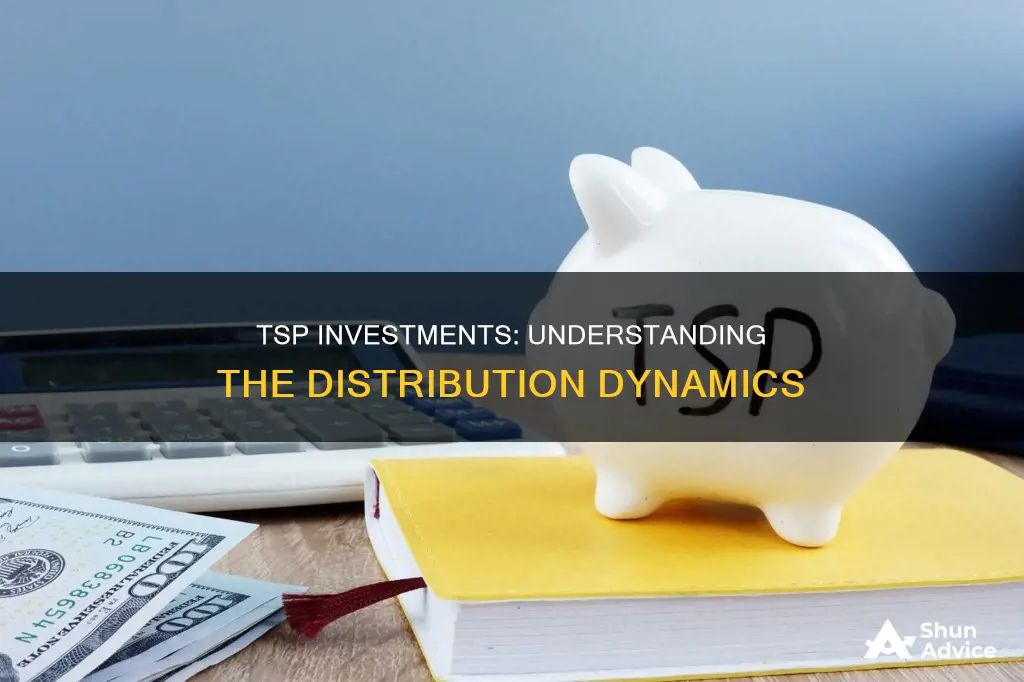
The Thrift Savings Plan (TSP) is a retirement investment program open only to federal employees and uniformed service members. It is a defined-contribution plan that offers many of the same benefits as those available to workers in the private sector. TSPs offer five core mutual funds to invest in, four of which are diversified index funds. Each index fund specializes in a different asset class or market segment, such as U.S. equities, international equities, and corporate bonds. The fifth core fund, the G Fund, invests in very low-risk, low-yield government bonds and guarantees principal protection to investors.
TSP withdrawal policies have changed to give account holders more flexibility, allowing an unlimited number of lump-sum withdrawals and more flexibility in the installment payment option. However, TSP investors can only withdraw monthly, quarterly, or annually, and there is a 10% early withdrawal penalty for those younger than 59 1/2.
Do TSP Investments Pay Distributions?
| Characteristics | Values |
|---|---|
| TSP Withdrawal Options | Lump sums, Installment payments, Life annuity |
| TSP Investment Options | Government Securities Investment (G) Fund, Fixed-Income Index Investment (F) Fund, Common-Stock Index Investment (C) Fund, Small-Capitalization Stock Index Investment (S) Fund, International-Stock Index Investment (I) Fund, Lifecycle (L) Funds |
| TSP Tax Status | Traditional (pretax), Roth (after-tax) |
| TSP Annual Contribution Limit | $22,500 for 2023, $23,000 for 2024 |
| TSP Catch-up Contribution Limit | $7,500 for individuals aged 50 and over |
| TSP Withdrawal Flexibility | Unlimited number of lump-sum withdrawals, flexible installment payments, ability to combine options |
| TSP Administrative Expenses | Typically 15-30 cents per $1,000 in the account |
What You'll Learn

TSP withdrawal options
- Partial distribution of a specified amount: You can request a partial distribution of at least $1,000 from your TSP account. This option allows you to access a portion of your funds while still receiving installments.
- Installments (automatic withdrawals): You can choose to receive payments from your TSP account monthly, quarterly, or annually. Installments provide a regular income stream and allow you to retain control over your savings and investment choices.
- Lump-sum withdrawals: You can withdraw your entire TSP account balance in a single payment. This option offers flexibility to use the funds as you wish, such as paying off debts or making large purchases. However, consider the tax implications, especially for traditional balances.
- Life annuity: You can use your TSP account to purchase a life annuity, providing guaranteed monthly payments for life. This option removes the burden of managing your investments in retirement but limits your flexibility.
These options can be combined to suit your needs. For example, you can choose to withdraw a lump sum and also set up installment payments. Additionally, you can leave your money in your TSP account as long as you wish, even after separating from federal service, as the TSP offers low-cost funds.
Invest Now: Where to Put Your Money
You may want to see also

TSP vs IRA
The Thrift Savings Plan (TSP) is a retirement savings plan offered by the US government to its employees and military personnel. It is similar to a 401(k) plan offered by private-sector employers. On the other hand, a Roth Individual Retirement Account (Roth IRA) is an individual retirement account that one can open and fund directly at a bank, brokerage, or other financial institution.
Taxes
Roth IRAs are funded with post-tax dollars, so Roth IRA distributions are tax-free. TSPs, on the other hand, can be traditional or Roth. Traditional TSPs are funded with pre-tax dollars, so you will owe income taxes on both the principal and the interest earned when you withdraw the money in retirement. Roth TSPs are funded with after-tax dollars, so the entire proceeds are tax-free in retirement.
Contribution Limits
For 2024, the TSP contribution limit is $23,000 if you're under 50, and $30,500 if you're 50 or older (including a catch-up contribution of $7,500). In contrast, the IRA contribution limit for 2024 is $7,000, with an additional $1,000 if you're 50 or older.
Income Limits
Roth IRAs have income limits for contributions, whereas TSPs do not. For 2024, you cannot contribute to a Roth IRA if your income is over $161,000 as a single filer or $240,000 as a joint filer.
Withdrawals
You can withdraw your Roth IRA contributions at any time without penalty, but you cannot withdraw money early from a TSP without paying a tax penalty. If you separate from federal service in the year you turn 55 or later, you will have penalty-free access to your TSP funds. For a Roth IRA, you will be subject to a 10% early withdrawal penalty for anything you take out before reaching 59 1/2.
Required Minimum Distributions (RMDs)
You must take RMDs from a Roth TSP starting at age 73 (this will change to 75 on January 1, 2033). There are no similar restrictions on a Roth IRA; you are not required to take RMDs during your lifetime.
Matching Contributions
If you are a federal employee or a member of the military, your agency or service will automatically contribute a minimum of 1% and up to 5% of your basic pay to your TSP account each pay period. There are no such matching contributions for IRAs.
Payroll Deduction
TSP contributions can only be made through payroll deduction from your federal salary. IRA contributions, on the other hand, can come from any source of earned income.
Flexibility
IRAs offer more flexibility than TSPs. You can roll money out of an IRA or withdraw funds at any time without leaving your job, whereas most TSPs do not allow this until you leave your job.
Investment Options
Both TSPs and IRAs offer a variety of investment funds and "lifecycle" funds to choose from. However, IRAs may offer more investment options and lower fees than TSPs.
Borrowing
You can borrow from a TSP, but you cannot borrow from an IRA.
Spouse Approval
TSPs require spouse approval for certain actions, whereas IRAs do not.
Backdoor Roth
Money in a TSP will not be subject to the pro-rata rule if you want to do a backdoor Roth, but this is not the case with a traditional IRA.
Both TSPs and IRAs are excellent retirement savings options, and there is no one-size-fits-all answer to which is better. It depends on your individual circumstances, tax situation, and financial goals. Many people choose to contribute to both a TSP and an IRA to maximize their retirement savings.
Cruise Investments: Worth the Money?
You may want to see also

TSP tax implications
The Thrift Savings Plan (TSP) is a direct-contribution retirement plan offered to US government employees. Similar to 401(k) plans, TSPs offer five core mutual funds to invest in, four of which are diversified index funds.
The tax implications of TSPs depend on whether the account holder has a traditional or Roth balance.
Traditional TSP
In a traditional TSP, contributions are made from pre-tax dollars, so the upfront tax break for employees is substantial. Investment earnings are tax-deferred until withdrawal. Generally, retirees are in lower tax brackets when they withdraw the money, which is an additional tax benefit.
When withdrawing from a traditional TSP, all distributions (including withdrawals, loans, death benefit distributions, court-ordered payments, and required minimum distributions) will be disbursed pro rata from the participant's traditional and Roth balances.
Withdrawals from a traditional TSP are fully taxable as ordinary income and do not receive favourable tax treatment like long-term capital gains or qualified dividends. The TSP is required to withhold 20% of any traditional TSP distributions to cover taxes, so account holders may need to withdraw more than initially anticipated. This 20% withholding is not necessarily indicative of the taxes owed, which could be more or less.
There is an age-based penalty for withdrawing from a traditional TSP too early. A 10% early withdrawal penalty will apply if the account holder separates from their federal job before the year they turn 55. However, there are exceptions for certain categories of employees, such as law enforcement officers, firefighters, and air traffic controllers, who are exempt from the early withdrawal penalty if they separate from service in the year they turn 50 or later.
Additionally, there is a 50% penalty for failing to take required minimum distributions (RMDs) beginning at age 70.5. This penalty is designed to ensure that individuals saving in tax-advantaged plans start taking distributions at a certain age.
Roth TSP
In a Roth TSP, investments are made with after-tax money, so on withdrawal, Roth investments, including earnings, are tax-free. To qualify for tax-free earnings, two conditions must be met:
- Five years have passed since January 1 of the calendar year in which the first Roth contribution was made (the "five-year rule").
- The account owner is at least 59.5 years old or disabled.
If these conditions are not met, the tax treatment of earnings depends on whether the payment is a "qualified distribution".
For uniformed services TSP accounts, contributions made from combat zone pay are not included as taxable income when withdrawn. However, any earnings on those contributions are subject to tax when distributed.
TSP Annuities
TSP account holders who have left or retired from federal service can purchase a TSP annuity. The tax implications depend on whether the account has a traditional or Roth balance. For traditional balances, taxes on contributions and earnings are deferred until the money is paid to the account owner from the TSP annuity and will be taxed as ordinary income. For Roth balances, contributions were made with after-tax dollars, so TSP annuity payments composed of Roth contributions will not be taxed.
Rollovers
A rollover is a tax-free withdrawal of cash or other assets from one qualified retirement plan or traditional IRA that is reinvested into another qualified plan or IRA. The amount rolled over is taxed later when it is withdrawn from the new account. Effective January 1, 2010, eligible TSP account owners can take some or all of their traditional TSP account and transfer it to a Roth IRA. However, all such transfers are fully taxable in the year of transfer.
Early Distributions
For individuals who receive a single payment from their TSP, the TSP must withhold 20% for federal income tax. This withholding also occurs if the account owner chooses to receive the account balance in monthly payments over less than ten years.
Any money paid to TSP account owners younger than 59.5 years old may be subject to an additional 10% tax on early distributions, unless one of the following conditions is met:
- The account owner separates from government service during or after the calendar year they reach age 55 or older.
- The account owner chooses to receive their account balance in monthly payments based on life expectancy.
- The account owner retires due to a total and permanent disability.
Additionally, specified federal law enforcement officers, customs and border protection officers, federal firefighters, and air traffic controllers are exempt from the 10% early withdrawal penalty if they separate from service in or after the year they turn 50.
State and Local Taxes
It is important to note that the TSP does not withhold state and/or local income taxes. Account holders should consider the tax laws in their state of residence when planning withdrawals.
Retirement Planning: Overcoming Investment Inertia
You may want to see also

TSP investment funds
The Thrift Savings Plan (TSP) is a retirement investment program that is only open to federal employees and uniformed service members, including the Ready Reserve. It is a defined-contribution (DC) plan that offers federal employees many of the same benefits that are available to workers in the private sector.
TSPs are similar to 401(k) plans offered by private employers. Participants in a TSP can get an immediate tax break for their savings and choose to invest in a Roth for freedom from taxes after retirement. The TSP offers a choice of six funds and a mutual fund option:
- The Government Securities Investment (G) Fund
- The Fixed-Income Index Investment (F) Fund
- The Common-Stock Index Investment (C) Fund
- The Small-Capitalization Stock Index Investment (S) Fund
- The International-Stock Index Investment (I) Fund
- Specific Lifecycle (L) funds
The G Fund is the only core fund that does not invest in an index. It invests in a special non-marketable treasury security issued specifically for the TSP by the US government. This fund is the only one in the TSP that guarantees the return of the investor's principal. It is intended for very conservative investors and has historically provided the lowest rate of return of any of the core funds.
The F Fund represents the next step up the risk/reward ladder in the TSP. This index invests in a wide range of debt instruments, including publicly traded treasury and government agency securities, corporate and non-corporate bonds, and asset-backed securities (ABS).
The C Fund is the most conservative of the three stock funds available in the TSP. The fund has experienced greater volatility than either the G or F Funds and has posted higher returns over time.
The S Fund holds the same securities as the Dow Jones U.S. Completion Total Stock Market Index, which is composed of over 4,000 companies. These companies are smaller and less established than the S&P 500 companies and have greater potential for growth than those in the C Fund. The S Fund is considered one of the two funds with the greatest risk in the TSP.
The I Fund invests in securities mirroring the Morgan Stanley Capital International EAFE (Europe, Australasia, Far East) Index. This is one of the broader international indexes investing in larger, more established companies located in 21 developed countries. It is regarded as the other high-risk fund in the TSP and has historically posted a higher average annual return than the C Fund.
The L Funds are composite funds that invest in a combination of the five core funds and act like target-date funds. They function as "automatic pilot" funds for participants who do not wish to make their own asset allocations. They are designed to provide the best possible mix of growth versus reward during both the growth and income phases of each fund.
TSP withdrawal policies have changed to give account holders much more flexibility, in response to feedback from investors. Two-fifths of TSP account holders transfer their money out on retirement or separation, most commonly into an IRA. However, this trend is happening despite the TSP's low overhead fees in comparison to IRA mutual funds.
Why Private Equity is Worth the Risk
You may want to see also

TSP eligibility
The Thrift Savings Plan (TSP) is a direct-contribution retirement plan offered to U.S. government employees. It is one of the simplest and most efficient retirement plans available today.
Eligibility
Most employees of the United States government are eligible to participate in the TSP. You are eligible if you are any of the following:
- A Federal Employees' Retirement System (FERS) employee (generally if you were hired on or after January 1, 1984)
- A Civil Service Retirement System (CSRS) employee (generally if you were hired before January 1, 1984, and did not convert to FERS)
- A member of the uniformed services (active duty or Ready Reserve)
- A civilian in certain other categories of government service
In addition to being covered by an eligible retirement system, you must also be:
- Actively employed by the federal government as a civilian employee or as a member of the uniformed services
- In a pay status in order to contribute
- Working full- or part-time
If you are a FERS employee, your agency has automatically enrolled you in the TSP, and a percentage of your basic salary is deducted each pay period and deposited in the traditional balance of your TSP account. If you are a CSRS employee, your account is established by your agency after you make a contribution election using your agency's electronic payroll system or by submitting the relevant form.
Withdrawing from the TSP
You have several options for how to use the money in your TSP account after you retire or separate from federal service. You can keep the money in your TSP account for as long as you want, and you can always move money into your TSP account by making rollovers from eligible employer plans and from traditional IRAs.
If you want to withdraw money from your TSP account, you can request a TSP withdrawal or distribution by logging in to your account or by contacting the ThriftLine. Withdrawals and distributions cannot be reversed once they have been processed, so it is important to carefully consider your options before submitting a request.
There are four options for taking money from your TSP account as a separated participant:
- Partial distribution of a specified amount
- Installments (automatic withdrawals)
- Purchase a life annuity
- Total distribution of your entire TSP account balance
You can request a distribution using one of these methods or any combination of them.
Young Investors: Why the Hesitation?
You may want to see also







